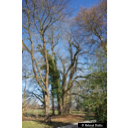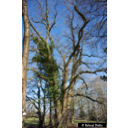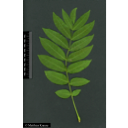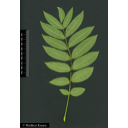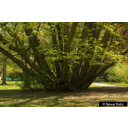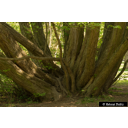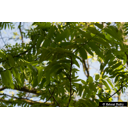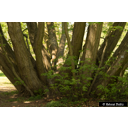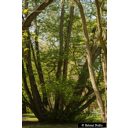Useful information about the taxon (species, subspecies, variety...)
Pterocarya fraxinifolia (Poir.) Spach 1834
Juglandaceae
(APG IV)Caucasian wingnut
Taxon concept: Plants of the World Online
Distribution: Caucasus, Northern Iran
Flowering period: VI
Pterocarya fraxinifolia (Poir.) Spach - Accepted: Pterocarya fraxinifolia (Poir.) Spach bei Zander 2008; Familie: Juglandaceae (Zander 2008)Pterocarya fraxinifolia (Poir.) Spach - unresolved: Pterocarya fraxinifolia (Poir.) Spach bei The Plant List (2010); Familie: Juglandaceae (APG III)Pterocarya fraxinifolia (Poir.) Spach - Unresolved: Pterocarya fraxinifolia (Poir.) Spach bei The Plant List (2014), version 1.1; Familie: Juglandaceae (APG III)
- Flowers
- monoecious; flowers in long catkins (up to 50 cm)
- Flower ecology
- wind-pollinated (anemophilous)
- Life form
- tree
- Leaves
- pinnately compound
- Foliage persistence
- deciduous
- Fruits
- double-winged nut fruit (samara)
- Fruit ecology
- wind-dispersed (anemochorous)
- Soil conditions
- preferentially on moist, loamy and clay soils
- Root type
- shallow root system
- Natural occurrence (habitat)
- river valleys
- Vegetation typ and synecology (plant community)
- temperate broad-leaved and mixed forests (Caspian Hyrcanian mixed forests)
- Usage
- used as an ornamental tree in parks and gardens; wood is used for the production of veneer; bast from the bark is used for weaving hats
- Phytopathogenic organisms
- is affected by the fungal pathogen Geosmithia morbida vectored by the walnut twig beetle Pithyophthorus juglandis
Erhardt, W., Götz, E., Bödeker, N. & Seybold, S. (2008): Der große Zander. Enzyklopädie der Pflanzennamen. Band 2. Arten und Sorten. Eugen Ulmer KG, Stuttgart (Hohenheim), 18. Aufl., 2103 S.; The International Plant Names Index (2009). Published on the Internet http://www.ipni.org; Courtesy to IPNI, 2009. Exported from IPNI at date: 2009-09-22 20:17:51;
Diese Webseite verwendet Google Maps, um Karten und Standorte von Pflanzen in den Hohenheimer Gärten anzuzeigen. Dadurch werden unter Umständen Daten an Google weitergeleitet, was mit einer Verarbeitung Ihrer personenbezogenen Daten verbunden sein kann. Die Datenschutzerklärung von Google finden Sie hier: Datenschutzerklärung von Google
| Sex | Standort | Accession number | Planting year | Donation | IPEN | Lat. | Long. |
|---|---|---|---|---|---|---|---|
| Klimabäume Hohenheim West | KLB-291-20480 | XX-0-HOH-KLB-291-20480 | 0 | 0 | |||
| Klimabäume Hohenheim West | KLB-292-20480 | XX-0-HOH-KLB-292-20480 | 0 | 0 | |||
| Klimabäume Hohenheim West | KLB-293-20480 | XX-0-HOH-KLB-293-20480 | 0 | 0 | |||
| Klimabäume Hohenheim West | KLB-294-20480 | XX-0-HOH-KLB-294-20480 | 0 | 0 | |||
| Klimabäume Hohenheim West | KLB-295-20480 | XX-0-HOH-KLB-295-20480 | 0 | 0 | |||
| Parzelle G | EG-G-064-13844 | 1934 | XX-0-HOH-EG-G-064-13844 | 48,7094076401 | 9,2061534541 | ||
| Parzelle M | SP-MB-004-10187 | 2021 | XX-0-HOH-SP-MB-004-10187 | 48,711389919 | 9,2155524777 | ||
| Parzelle M | SP-MB-006-10189 | 2021 | XX-0-HOH-SP-MB-006-10189 | 48,7114336175 | 9,2154589602 | ||
| Parzelle M | SP-MB-007-10190 | 2021 | XX-0-HOH-SP-MB-007-10190 | 48,7114507337 | 9,2154474833 | ||
| Parzelle M | SP-MB-008-10191 | 2021 | XX-0-HOH-SP-MB-008-10191 | 48,7113951607 | 9,2153221263 | ||
| Parzelle M | SP-MB-009-10192 | 2021 | XX-0-HOH-SP-MB-009-10192 | 48,7114853922 | 9,2153649334 | ||
| Parzelle M | SP-MB-011-16545 | 2021 | XX-0-HOH-SP-MB-011-16545 | 48,7113390758 | 9,2154369108 |

